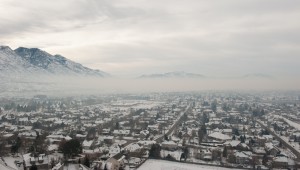Inversions and bad air quality in the Salt Lake and Utah valleys are causing health issues for many people as the cold weather has settled.
The Utah Department of Health did a study on the effects of wintertime smog in the valleys. The study showed that on the fifth to seventh day of the inversion, a significant amount of symptoms increased.

Kellie Baxter, the health program specialist for the Utah Department of Health Asthma Program, said there were many different smog-related symptoms.
“The most common things they’ll experience are coughing and having excess mucus production because they’re trying to breathe in,” she said. “It’s a sign that what they’re breathing in is bad for their lungs.” Baxter offers that people should spend more time indoors to avoid polluting their lungs.
The reason for the poor air quality can be attributed to a few things. Not only do the cold temperatures play a role, but the topography of the mountains traps the poor air into the valley like a lid.
Donna Spangler, the communications director for the Utah Department of Environmental Quality, explained that what in the air is the cause of all this commotion. “The pollutant of concern is particulate matter, known as PM 2.5 (tiny, small, soot-like particles that are one-tenth the size of a human hair),” Spangler said. “It’s a health concern when people breathe in the particles because they can get trapped in the lungs and causes inflammation.”
The only thing capable of removing the pollutants from the valley is a large storm. Until a storm comes and knocks out the inversion, Spangler suggests people stay inside as much as possible and “drive less during inversions, otherwise the pollution keeps building.”
The Department of Environmental Quality actually prohibits the burning of wood in fireplaces during bad inversions to reduce pollutants in the air as well.
Riley Hendrickson, an Orem resident, commutes to Salt Lake daily for his job as a Questar gas land-man. The inversion in Salt Lake appears worse than the smog in the Provo/Orem area.
“It’s hard enough digging holes on a nice day with fresh air, but with the lower temperatures and minimal air to breath due to the inversion, it makes it nearly impossible and makes a job twice as long,” Hendrickson said.
The best thing to do is stay inside and avoid inhaling the poor air. Precautionary measures should be taken until the next big storm can punch out the inversion.




